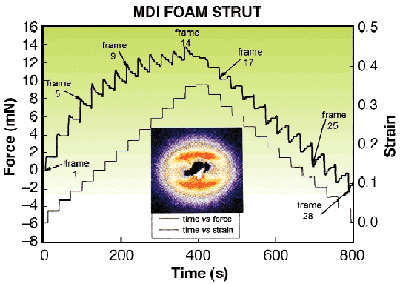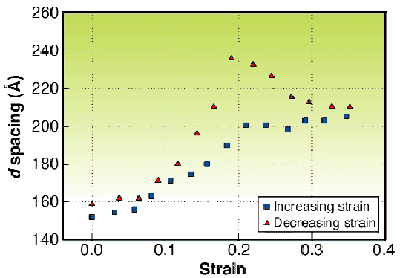- Home
- Users & Science
- Scientific Documentation
- ESRF Highlights
- ESRF Highlights 2000
- Microfocussing and Imaging
- Micro-SAXS from Polyurethane Foams
Micro-SAXS from Polyurethane Foams
Despite the established significance of elastomeric polyurethane (PU) foams in automotive and furniture applications, a microstructural model of the response of foam structures to strain and environmental conditions is still being developed. Ideally one would like a direct correlation of the mechanical properties of the PU elastomer comprising the foam upon deformation, with the response of the polymer mesophase structure. While small-angle X-ray scattering (SAXS) is a classical technique to characterise such mesophases, its beam size has to be small enough to investigate a single structural unit. PU foams contain only 2-5 percent by volume of polymer, concentrated in small structural units called struts which are typically 100-300 µm in length with a triangular cross-section with a side dimension which is typically 30-80 µm. Thus their individual isolation from bulk foam and the subsequent characterisation of their structural properties is not a trivial task.
A collaboration between Keele University, Huntsman Polyurethanes and staff on the Microfocus Beamline ID13 at the ESRF has addressed these difficulties by developing micro-surgery and micro-deformation techniques in parallel with micro-SAXS instrumentation [1,2]. This allowed the study of structural reorganisation in single struts of foam as a function of strain under variable conditions. In the ID13 experiments, a purpose-designed piezo-electrically driven micro-deformation stage was combined with micro-SAXS optics to simultaneously collect strain, force and micro-SAXS data in real-time. The SAXS data were collected down to a lower s-limit of 1.5 x 10-3 Å-1 (s=1/d) using beam sizes of 5-10 µm diameter. Single struts were deformed during these experiments to various strains up to a maximum of about 2.
 |
Fig. 114: Data from an incremental cyclic deformation experiment. Upper curve: Force data demonstrating stress relaxation phenomenon in both phases of the strain cycle. Lower curve: 30-second strain increments. Inset: Anisotropic micro-SAXS data from the point of maximum strain.
|
The force/strain and stress relaxation data collected from elastomeric PU foams, based on methylenediphenyleneisocyanate (MDI), displayed hysteresis characteristics and stress relaxation rates which are comparable with PU bulk elastomers. Typical force/strain and micro-SAXS data collected during a single strain cycle of a single strut are presented in Figure 114. The SAXS data indicated that the hard-soft lamellae of the polymer mesophase structure tend to orient in the direction of drawing with a spacing which increases with strain. In addition, at higher elongations, the scattered intensity reduced suggesting a partial, but reversible, destruction of the hard-soft lamellae structure. In experiments where the strain rate exceeded the stress relaxation rate it was possible to observe increasing hard block separation simultaneously with decreasing gross strain during the initial part of the return phase of the strain cycle (see Figure 115).
 |
Fig. 115: Variation of the separation of the scattering units as a function of strain for the experiment illustrated in Figure 114.
|
The results obtained from this series of experiments provide a unique insight into the structural properties of PU foams. With the novel techniques and instrumentation which have been developed, further experiments are planned to develop realistic models of the complex behaviour of foam under deformation.
References
[1] C. Riekel, P. Engström and C. Martin, J. Macromol. Sci., B37, 587-599 (1998).
[2] C. Riekel, M. Burghammer and M. Müller, J. Appl. Cryst., 33, 421-423 (2000).
Principal Publication and Authors
C. Martin (a), G. Eeckhaut (b), A. Mahendrasingam (a), D.J. Blundell (a), W. Fuller (a), R.J. Oldman (c), S.J. Bingham (a), T. Dieing (d) and C. Riekel (d), J. Synchrotron Rad., 7, 245-250 (2000).
(a) Keele University (UK)
(b) Huntsman Polyurethanes, Everberg (Belgium)
(c) ICI, Runcorn (UK)
(d) ESRF



